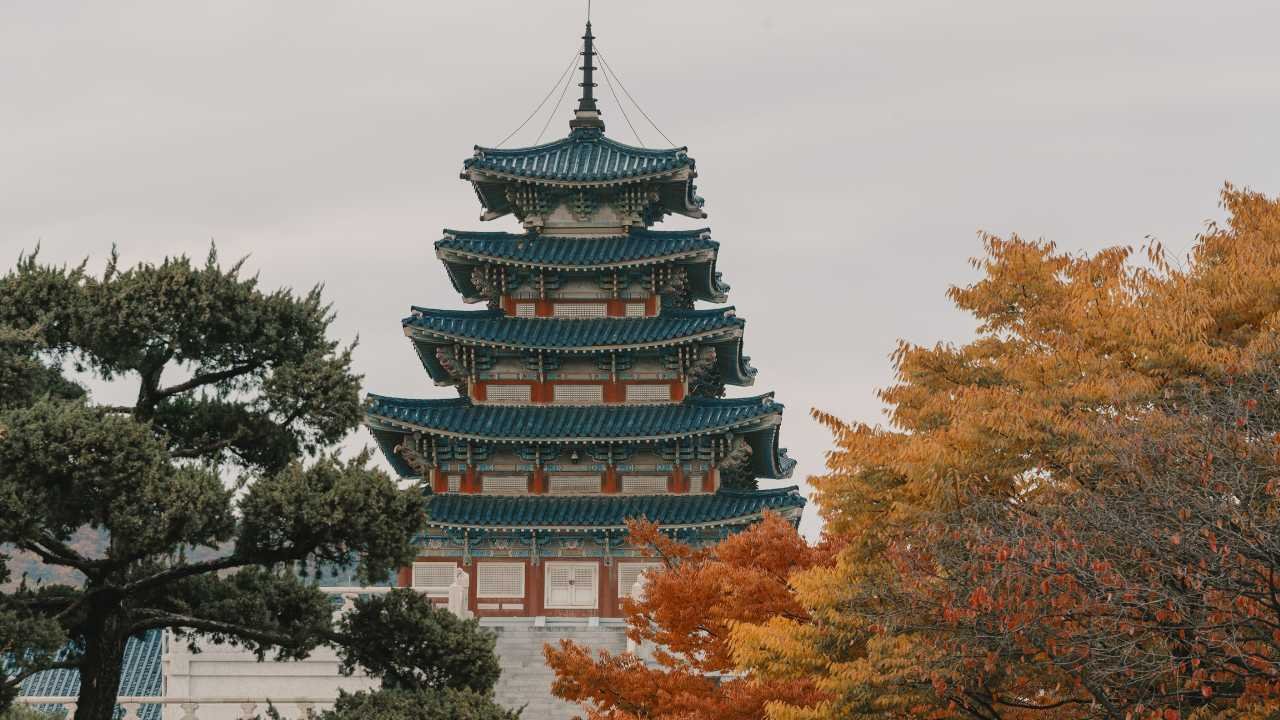South Korea is home to some of the most breathtaking Buddhist temples you’ll ever see.
Whether you’re into architecture, hiking, culture, or just need a peaceful break from the city rush, these temples offer a soulful escape into Korea’s spiritual heart.
Here are 20 stunning Buddhist temples in Korea that every traveler should add to their itinerary.
1. Beopjusa Temple (보은 법주사)
Founded in 553 AD, Beopjusa was a major training center for monks during the Silla Dynasty. The temple houses the iconic 33-meter-high Golden Maitreya Buddha and Korea’s tallest wooden pagoda. Its natural forest surroundings offer a tranquil retreat for hikers and spiritual travelers alike.
Why visit? For its golden Buddha, wooden pagoda, and peaceful mountain backdrop.
2. Tongdosa Temple (통도사)
Established in 646 AD by the monk Jajang, this temple enshrines actual relics of the Buddha, making it one of the most sacred in Korea. It’s also one of the Three Jewel Temples, representing the Buddha himself.
Why visit? A rare chance to witness sacred relics and walk a temple with no statues—only spirit.
3. Magoksa Temple (마곡사)
Built in the 7th century, Magoksa Temple has a strong connection to Seon (Zen) Buddhism. Its quiet pine forest location makes it less crowded but deeply rewarding.
Why visit? A meditative experience in the forest with ancient charm.
4. Sudeoksa Temple (수덕사)
With origins tracing back to the Baekje era, this temple was a stronghold of Buddhist education. Its Daeungjeon Hall is a national treasure and one of the oldest wooden buildings in Korea.
Why visit? For historical architecture and peaceful morning chants.
5. Jogyesa Temple (조계사)
Founded in the 14th century and rebuilt in 1910, this temple is the headquarters of Korean Zen Buddhism. It is vibrant with color, especially during Buddha’s Birthday, when lanterns decorate the sky.
Why visit? It’s the heart of Buddhism in Seoul—easy to access, full of culture.
6. Beomeosa Temple (범어사)
Dating back to 678 AD, this temple was built on the slopes of Geumjeongsan Mountain. It played an important role during the Imjin War and remains a pilgrimage site.
Why visit? Ideal for those exploring Busan who want a dose of history and nature.
7. Guinsa Temple (구인사)
Founded in the 20th century by the monk Sangwol Wongak, Guinsa is the headquarters of the Cheontae Order. Its vertical layout between steep mountains is stunning.
Why visit? Unique temple architecture and free temple meals for visitors.
8. Buseoksa Temple (부석사)
Founded in 676 AD by the monk Uisang, it houses one of the oldest wooden buildings in Korea and stunning stone pagodas. It is deeply tied to Hwaeom Buddhism.
Why visit? For its mystical legends, panoramic views, and ancient halls.
9. Daeheungsa Temple (대흥사)
This temple played a major role during the Imjin War and was a base for Buddhist militias. Nestled in Duryunsan, it has beautifully preserved meditation halls.
Why visit? For a mix of military history and spiritual refuge.
10. Bongwonsa Temple (봉원사)
Founded in 889 AD, Bongwonsa is the headquarters of the Taego Order of Buddhism. It sits near Yonsei University and is known for its unique rituals.
Why visit? Hidden in Seoul, offering tradition and tranquility.
11. Bulguksa Temple (경주 불국사)
A UNESCO World Heritage site built in the 8th century, Bulguksa is Korea’s most famous temple. It features national treasures like Dabotap and Seokgatap pagodas.
Why visit? The crown jewel of Korean Buddhist art and architecture.
12. Sinheungsa Temple (신흥사)
Located inside Seoraksan National Park, this 7th-century temple has a massive bronze Buddha statue and incredible mountain views.
Why visit? Combine a temple visit with Korea’s most scenic national park.
13. Geumsansa Temple (금산사)
Built in the 7th century, Geumsansa served as a training ground for Buddhist soldiers. It houses several relics and large wooden halls.
Why visit? For those fascinated by temple defense history and rural beauty.
14. Baegyangsa Temple (백양사)
Surrounded by cliffs and waterfalls, this Baekje-era temple is a nature lover’s dream. It’s particularly beautiful in autumn.
Why visit? Best visited during fall foliage for postcard-perfect views.
15. Bongseonsa Temple (봉선사)
Founded in 969 AD, Bongseonsa has served the royal family during the Joseon Dynasty. It’s surrounded by peaceful hills and traditional pavilions.
Why visit? A touch of royal history and countryside charm.
16. Bongeunsa Temple (봉은사)
Built in 794 AD, this temple is located across from COEX Mall in Gangnam in Seoul. It offers temple stays and cultural programs.
Why visit? Easy to reach, culturally rich, and urban yet peaceful.
Many people might prefer to travel around Seoul and see the temples here. Here you can visit and see the 10 famous temples of Seoul that are very close to you.
17. Doseonsa Temple (도선사)
This 15th-century temple lies at the foot of Bukhansan. Known for its mountain energy and quietness, it’s ideal for urban hikers.
Why visit? For hikers and meditation lovers needing a Seoul escape.
18. Naksansa Temple (낙산사)
Founded by the famous monk Uisang in 671 AD, it overlooks the East Sea and has a massive white statue of Avalokitesvara (Gwanseum).
Why visit? Ocean views, sunrise experiences, and beautiful cliffside walks.
19. Yeonghwasa Temple (연화사)
This coastal temple is famous for its Buddha statue facing the sea. It’s quiet and lesser-known, but ideal for contemplation.
Why visit? Beach and Buddha—a rare and serene combo.
20. Ssanggyesa Temple (쌍계사)
Dating back to 722 AD, this temple was built by monks who brought tea seeds from China. It remains a center for Korean tea culture.
Why visit? Learn about Korea’s tea roots while enjoying stunning forest surroundings.
Final Thought:
From city temples to mountain hideaways, South Korea’s Buddhist temples are perfect places to reflect, explore, and reconnect. Whether it’s history, nature, or spirituality you seek—there’s a temple for every kind of traveler.

